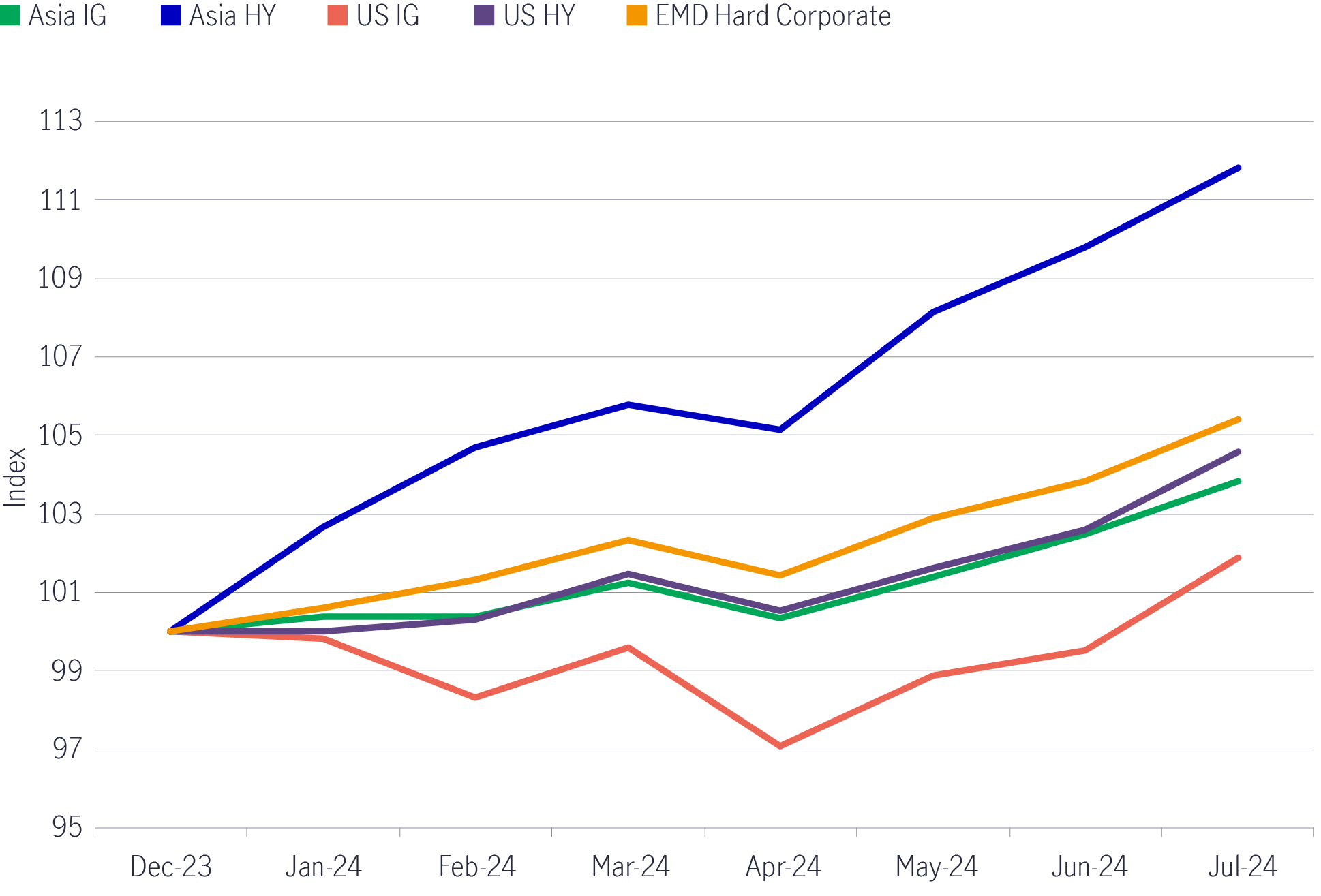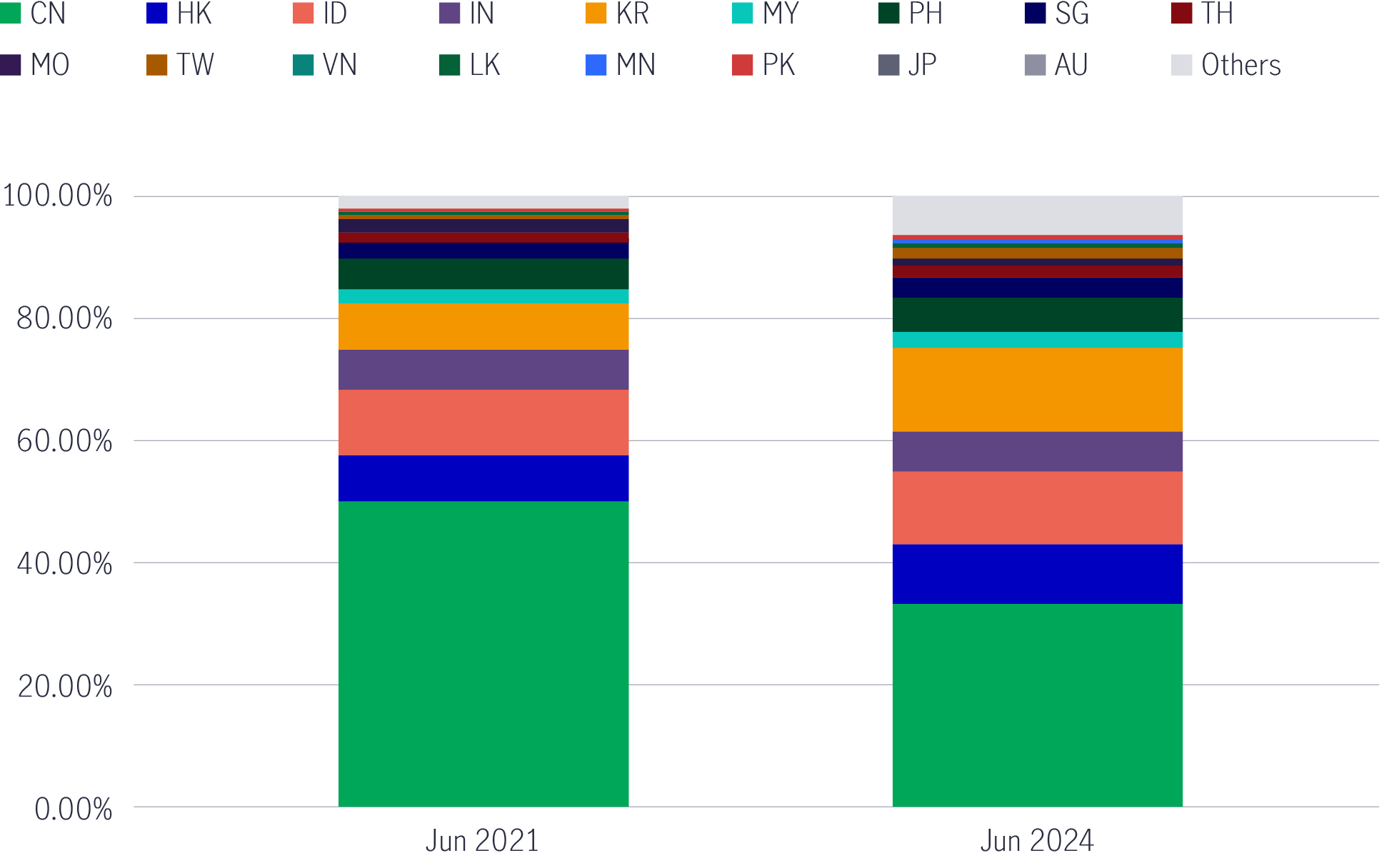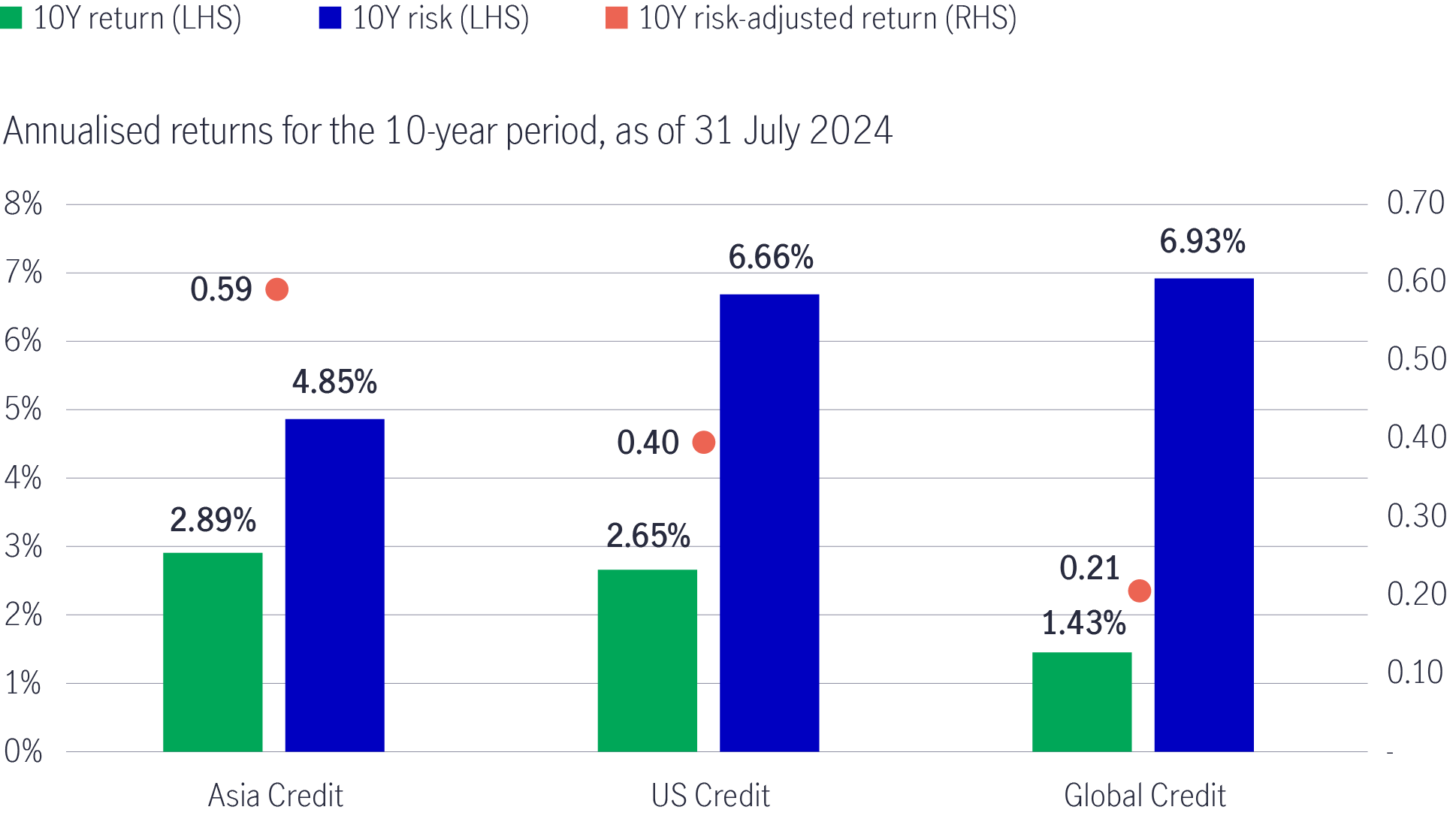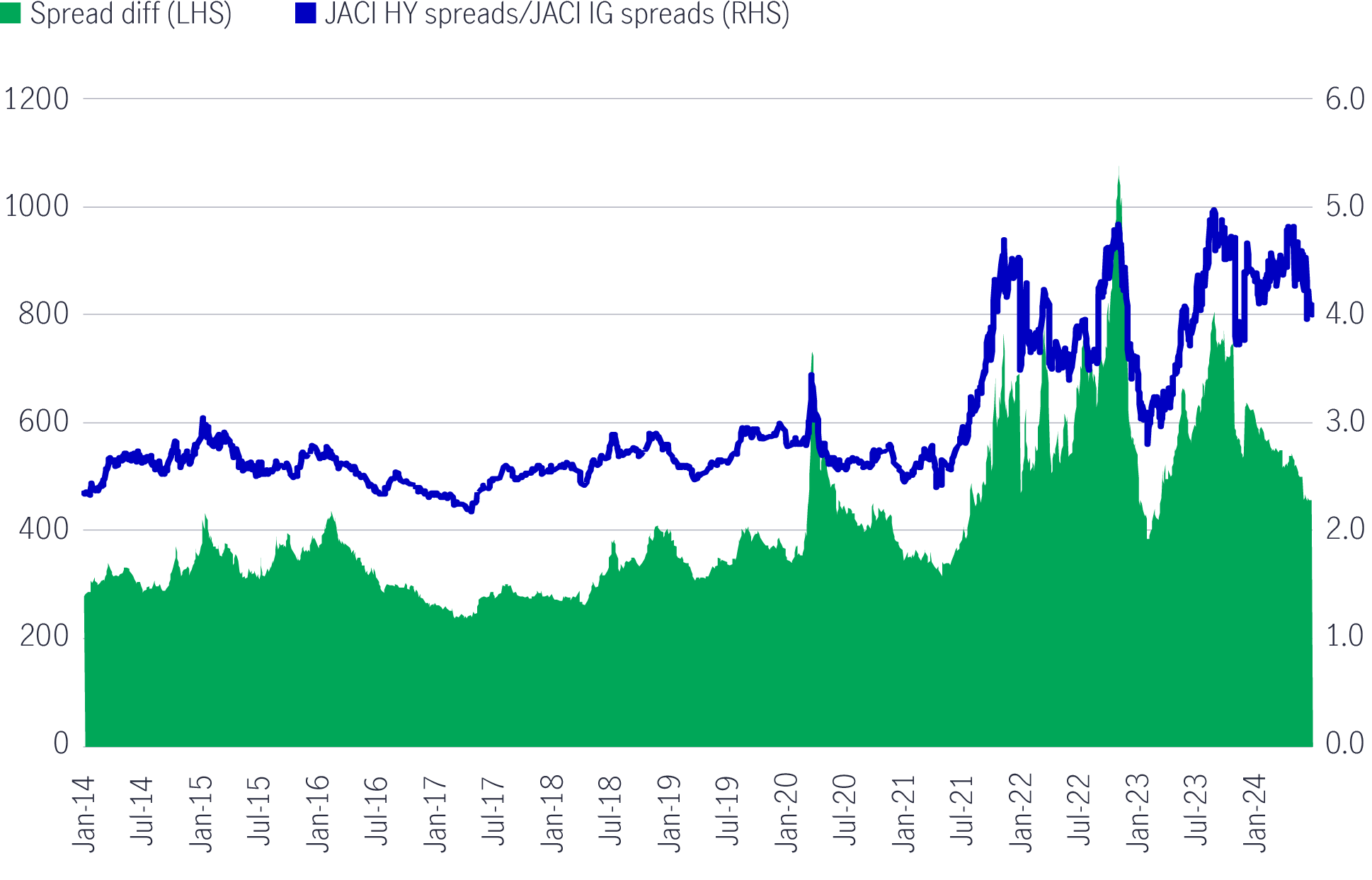Asian Credit: Three themes should propel returns in 2H 2024
Asian credit showed accelerating momentum in the first half of 2024 as strong technical factors such as tight supply, coupled with robust economic growth and additional policy stimulus in China, helped lift the asset class. In this investment note, Murray Collis and the pan-Asian fixed-income team identify three themes that they believe should continue to support Asian credit in the second half of the year, presenting attractive opportunities for investors.

Asian credit posted solid gains over the first half of 2024, despite uncertainty around U.S. Treasury yields and market-related events such as regional elections. With attractive all-in yields on offer, investors keenly added Asian credit exposure to lock in favourable income opportunities, which underpinned a broad tightening of credit spreads across the region.
Asian high yield (HY) particularly stood out, rising 11.83% year to date, significantly outperforming other fixed-income sectors.1 This performance was helped by notably improved market sentiment after the Chinese government released a raft of supportive programmes.
Asian credit performance, year to date

Targeted assistance for the property sector, coupled with more accommodative monetary policy and consumption-related stimulus, propelled returns. Greater stability in frontier markets also contributed, as these countries emerged from credit distress with support from the International Monetary Fund (IMF) and external creditors on debt restructuring.
Meanwhile, Asian investment-grade (IG) bonds continued to demonstrate their ongoing resilience, gaining 3.84% over the same period due to tighter credit spreads and a strong technical catalyst in the form of limited bond supply.1
2H 2024: three themes to support Asian credit
For the remainder of 2024, we believe Asian credit is well placed to continue navigating an uncertain macro landscape due to three compelling themes:
1 Resilient fundamentals and lower default rates
2 Positive structural changes in the investment universe, leading to more diverse market opportunities
3 Superior risk-adjusted returns for the asset class versus global peers
Resilient fundamentals and lower default rates
Asian credit has proven resilient over the past few years despite experiencing numerous challenges, including the impact of COVID-19 and the China property sector crisis. Although these events characterised 2022 and 2023, we believe the credit cycle in the region has bottomed and now presents attractive opportunities for investors.
Strong regional economic fundamentals will support the asset class’s momentum moving forward. The growth stories in India and Indonesia, catalysed by shifting global supply chains and increasing manufacturing onshoring, are compelling and should drive regional dynamics and potential credit upgrades despite lingering economic concerns in China.
Indeed, India posted the fastest growth rate of the world’s largest economies in 2023 at 7.2%. Looking forward, although Asia’s economic growth is forecast to moderate slightly to 4.3% in 2025, it remains the growth standout compared to other major regions. Importantly, Asia still contributes around 60% of global GDP and remains the world’s most dynamic economic region.
Additionally, we expect historically elevated default rates to continue trending lower. The surge in defaults and downgrades over the past several years was largely concentrated in China’s property sector and the local government funding vehicles segment, while the rest of the region experienced meaningfully lower levels of distress.2
Asia’s HY default rate has declined from its peak

Finally, frontier economies in the region have also stabilised somewhat after being in distressed territory. We’re cautiously constructive on these markets as they gradually return to growth; however, the path to normalisation remains bumpy.
Sri Lanka is expected to emerge from sovereign default in the near term on the back of IMF support and agreements struck with creditors to restructure its external debt in July. While the economic situation, supported by a rebound in tourism, has notably improved, uncertainty remains as presidential elections approach in September and difficult structural reforms to keep the IMF programme on track are on the political agenda.
Meanwhile, the newly elected government in Pakistan is implementing structural reforms of its own to address fiscal challenges and secure further support from the IMF and other bilateral lenders. However, volatility may still arise from political challenges and external shocks that could hinder reform progress and delay the IMF programme.
Positive structural changes in the investment universe should lead to more diverse market opportunities
Asia’s credit universe has experienced significant structural change over the past two years. While still the largest country weight represented, China’s overall weight in the J.P. Morgan Asia Credit Index has now been reduced to around 34% due to limited supply from China and overall net redemptions by issuers over the past few years.
While the country is still expected to play a key role moving forward, other regional economies such as India, Indonesia, and South Korea should contribute to a more diverse credit market.3
Asia’s credit universe is evolving

Furthermore, Japan and Australia, traditionally the territory of developed markets, have risen in importance among Asian investors, particularly with the introduction of the J.P. Morgan Asia Credit Asia-Pacific Index in 2023. These credits provide a different economic profile than others in the region, leading to enhanced diversification opportunities.
Superior risk-adjusted returns versus global peers
Asia has emerged from the volatility seen in the past few years with its fundamental long-term investment thesis intact. The region’s credit market continues to offer superior risk-adjusted returns compared to other global credit markets, making the asset class attractive.4
Chart 4: Global credit comparison of risk-adjusted returns

Currently, Asian IG and HY bonds also offer a decent spread pickup compared with U.S. and global credit, which should provide a buffer against expected U.S. rate volatility.
From an income perspective, both Asian IG and HY credit, which are yielding above 5% and 10%, respectively, are expected to remain attractive for investors, especially as short-end rates are expected to decline later this year should the U.S. Federal Reserve follow through with rate cuts in September as per the market’s expectations.
If we consider these segments from a potential total return perspective, we currently prefer HY over IG due to current valuations for HY looking more attractive compared with historical levels.5
Asian HY at historically attractive levels versus IG

HY spreads have notably tightened since the Chinese government released supportive measures for the property sector in October 2023. However, the spread pickup over IG remained at roughly 500 basis points as of the end of June, which is still historically high.5
Specifically, in HY, offshore bonds issued by China's property sector have posted a significant rebound year to date following the government moves to stabilise the sector. Lower defaults and a much smaller weight of the property sector in the HY universe should result in much less of a drag on returns moving forward. Further stimulus measures should also be supportive of other non-property-related sectors in China’s HY segment.
In addition, we believe there’s value in selected perpetual bonds in Asia, which are poised to benefit from a U.S. rate-cut cycle and issuers’ strong access to alternative funding in local markets. We see the potential for fixed-for-life perpetual bonds to rally as it becomes more economical for issuers to call back their bonds, while their lower cash prices and high current yields offer some downside protection for investors.
Looking forward, several positive catalysts exist for upside: credit improvement stories such as a potential sovereign credit upgrade in India and frontier markets. Favourable technical factors with a manageable new bond supply pipeline should also serve as a favourable tailwind for the asset class.
Three key themes can help drive credit returns, with HY leading the way
We believe the three core themes discussed, including the region’s resilient fundamentals and lower default rates, positive structural developments, and attractive risk-adjusted returns for Asian credit, should continue to help drive returns for the asset class in the second half of 2024.
HY is particularly attractive as valuations remain compelling, with a high potential for solid returns over the next six to twelve months due to favourable market technical dynamics and further expected declines to default rates. IG is also well positioned to offer investors stable income and remain resilient due to the region’s economic strength.
Finally, the expansion of the investment universe to traditionally developed markets offers new possibilities for diversification and portfolio construction. These catalysts aren’t only attractive to Asian investors but also to many global funds that have been waiting on the sidelines for a sustained recovery in the asset class to materialise.
1 Bloomberg, J.P. Morgan Asia Credit Index, as of July 31, 2024. 2 Bank of America Global Research, ICE Data Services, as of June 30, 2024. 3 J.P. Morgan Asia Credit Index, as of June 30, 2024. 4 Bloomberg, Manulife Investment Management analysis, as of June 30, 2024. 5 Bloomberg, as of June 30, 2024.
Investing involves risks, including the potential loss of principal. Financial markets are volatile and can fluctuate significantly in response to company, industry, political, regulatory, market, or economic developments. These risks are magnified for investments made in emerging markets. Currency risk is the risk that fluctuations in exchange rates may adversely affect the value of a portfolio’s investments.
The information provided does not take into account the suitability, investment objectives, financial situation, or particular needs of any specific person. You should consider the suitability of any type of investment for your circumstances and, if necessary, seek professional advice.
This material is intended for the exclusive use of recipients in jurisdictions who are allowed to receive the material under their applicable law. The opinions expressed are those of the author(s) and are subject to change without notice. Our investment teams may hold different views and make different investment decisions. These opinions may not necessarily reflect the views of Manulife Investment Management or its affiliates. The information and/or analysis contained in this material has been compiled or arrived at from sources believed to be reliable, but Manulife Investment Management does not make any representation as to their accuracy, correctness, usefulness, or completeness and does not accept liability for any loss arising from the use of the information and/or analysis contained. The information in this material may contain projections or other forward-looking statements regarding future events, targets, management discipline, or other expectations, and is only current as of the date indicated. The information in this document, including statements concerning financial market trends, are based on current market conditions, which will fluctuate and may be superseded by subsequent market events or for other reasons. Manulife Investment Management disclaims any responsibility to update such information.
Neither Manulife Investment Management or its affiliates, nor any of their directors, officers or employees shall assume any liability or responsibility for any direct or indirect loss or damage or any other consequence of any person acting or not acting in reliance on the information contained here. All overviews and commentary are intended to be general in nature and for current interest. While helpful, these overviews are no substitute for professional tax, investment or legal advice. Clients should seek professional advice for their particular situation. Neither Manulife, Manulife Investment Management, nor any of their affiliates or representatives is providing tax, investment or legal advice. This material was prepared solely for informational purposes, does not constitute a recommendation, professional advice, an offer or an invitation by or on behalf of Manulife Investment Management to any person to buy or sell any security or adopt any investment strategy, and is no indication of trading intent in any fund or account managed by Manulife Investment Management. No investment strategy or risk management technique can guarantee returns or eliminate risk in any market environment. Diversification or asset allocation does not guarantee a profit or protect against the risk of loss in any market. Unless otherwise specified, all data is sourced from Manulife Investment Management. Past performance does not guarantee future results.
Manulife Investment Management
Manulife Investment Management is the global wealth and asset management segment of Manulife Financial Corporation. We draw on more than a century of financial stewardship to partner with clients across our institutional, retail, and retirement businesses globally. Our specialist approach to money management includes the highly differentiated strategies of our fixed-income, specialized equity, multi-asset solutions, and private markets teams—along with access to specialized, unaffiliated asset managers from around the world through our multimanager model.
This material has not been reviewed by, is not registered with any securities or other regulatory authority, and may, where appropriate, be distributed by the following Manulife entities in their respective jurisdictions. Additional information about Manulife Investment Management may be found at manulifeim.com/institutional
Australia: : Manulife Investment Management Timberland and Agriculture (Australasia) Pty Ltd, Manulife Investment Management (Hong Kong) Limited. Canada: Manulife Investment Management Limited, Manulife Investment Management Distributors Inc., Manulife Investment Management (North America) Limited, Manulife Investment Management Private Markets (Canada) Corp. Mainland China: Manulife Overseas Investment Fund Management (Shanghai) Limited Company. European Economic Area: Manulife Investment Management (Ireland) Ltd. which is authorised and regulated by the Central Bank of Ireland Hong Kong: Manulife Investment Management (Hong Kong) Limited. Indonesia: PT Manulife Aset Manajemen Indonesia. Japan: Manulife Investment Management (Japan) Limited. Malaysia: Manulife Investment Management (M) Berhad 200801033087 (834424-U) Philippines: Manulife Investment Management and Trust Corporation. Singapore: Manulife Investment Management (Singapore) Pte. Ltd. (Company Registration No. 200709952G) South Korea: Manulife Investment Management (Hong Kong) Limited. Switzerland: Manulife IM (Switzerland) LLC. Taiwan: Manulife Investment Management (Taiwan) Co. Ltd. United Kingdom: Manulife Investment Management (Europe) Ltd. which is authorised and regulated by the Financial Conduct Authority
United States: John Hancock Investment Management LLC, Manulife Investment Management (US) LLC, Manulife Investment Management Private Markets (US) LLC and Manulife Investment Management Timberland and Agriculture Inc. Vietnam: Manulife Investment Fund Management (Vietnam) Company Limited.
Manulife, Manulife Investment Management, Stylized M Design, and Manulife Investment Management & Stylized M Design are trademarks of The Manufacturers Life Insurance Company and are used by it, and by its affiliates under license.
3826396



